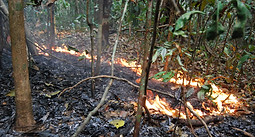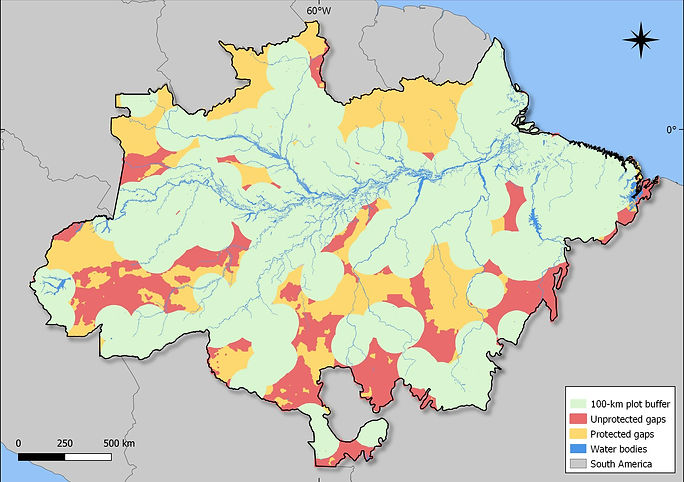


Synthesizing vegetation studies distribution in the Brazilian Amazon
Authors: Angélica Resende, Fernando Elias, Erika Berenguer, Flavia Costa, Ima Vieira, Juliana Schietti, Luiz Aragão, Oliver Phillips, Hans ter Steege, Filipe França, Raquel Carvalho, Matheus Guedes, Alexander Lees, Data Owners*, Jos Barlow, Joice Ferreira
Abstract
We examine the coverage of studies across the Brazilian Amazon assessing locations from around 3,000 forest plots using big databases (ForestPlots, ATDN) plus individual invitations. More than a third of the region has no plot in a 100-km radius. Research efforts are required, particularly in the Southeastern region, where the degradation sources are prevalent.

A
Logging

B


Fire
Drought
C
D

Edge effect
E
Drought
Photos by Filipe França (A and B), Erika Berenguer (C and E) and Adriane Esquivel-Muelbert (D).
01
The interactions between forest degradation and climate change are a major threat to the Amazon megadiversity. Degradation is caused by fires, timber logging, and other threats including fragmentation and edges left from deforestation.
02


From 3,235 forest plots only 14% (n=455) were on areas impacted by logging, fire or forest fragmentation and border effect (Matricardi et al 2020). Most forest plots (73%) are in primary forests. Other degradation sources were not accounted here.

Research investments and efforts are required, particularly in the peripheric regions of the Brazilian Amazon. We call attention to the Southeastern region, where the degradation sources are prevalent. Collaborate by sharing your data with us!
References:
Silva-Souza & Souza:
Have forest plots to share?
CONTACT
Synergize
Abstract
We examine the coverage of studies across the Brazilian Amazon assessing locations from around 3,000 forest plots using big databases (ForestPlots, ATDN) plus individual invitations. More than a third of the region has no plot in a 100-km radius. Research efforts are required, particularly in the Southeastern region, where the human-driven disturbance is prevalent.

A
Unsustainable logging

B
Unsustainable logging

Fire
C

D
Drought

E
01
The interactions between forest degradation and climate change are a major threat to the Amazon megadiversity. Degradation is caused by fires, logging, and other factors such as fragmentation and edge effects as a consequence of deforestation.
Drought
Edge effect
Photos by Flavio Forner (A and B), Erika Berenguer (C and E) and Adriane Esquivel-Muelbert (D).
02
We examine the spatial distribution of vegetation studies across the Brazilian Amazon. Assessing locations from more than 3,200 forest plots we found that more than a third of the region has no plot in a 100-km radius.


03
Considering the density of plots in each woody plant-subregion (Silva-Souza & Souza 2020), the Central and Eastern Amazon regions were better represented within Brazil.
04
About 14% (n=455) of forest plots were in areas impacted by logging, fire, or forest fragmentation and edge effect (Matricardi et al 2020). Around 55% of the plots are within areas where the projected increase in the dry length for 2100 will be more than 10 days (INPE).

05
Research investments and efforts are required mainly in the peripherical regions of the Brazilian Amazon. We call attention to the South and Eastern regions, where forest degradation and climate change are likely to have the greatest impacts. Collaborate by sharing your data with us!
References:
- Silva‐Souza, Karla JP, and Alexandre F. Souza. "Woody plant subregions of the Amazon forest." Journal of Ecology (2020).
- Matricardi, Eraldo Aparecido Trondoli, David Lewis Skole, Olívia Bueno Costa, Marcos Antonio Pedlowski, Jay Howard Samek, and Eder Pereira Miguel. "Long-term forest degradation surpasses deforestation in the Brazilian Amazon." Science 369, no. 6509 (2020): 1378-1382.
- INPE, Os dados e mapas foram extraídos no Portal de Mudanças Climáticas no Brasil do INPE/MCTI, disponível em www.pclima.inpe.br.
- IPCC, 2018: Annex I: Glossary [Matthews, J.B.R. (ed.)]. In: Global Warming of 1.5°C. An IPCC Special Report on the impacts of global warming of 1.5°C above pre-industrial levels and related global greenhouse gas emission pathways, in the context of strengthening the global response to the threat of climate change, sustainable development, and efforts to eradicate poverty [Masson-Delmotte, V., P. Zhai, H.-O. Pörtner, D. Roberts, J. Skea, P.R. Shukla, A. Pirani, W. Moufouma-Okia, C. Péan, R. Pidcock, S. Connors, J.B.R. Matthews, Y. Chen, X. Zhou, M.I. Gomis, E. Lonnoy, T. Maycock, M. Tignor, and T. Waterfield (eds.)]. In Press
